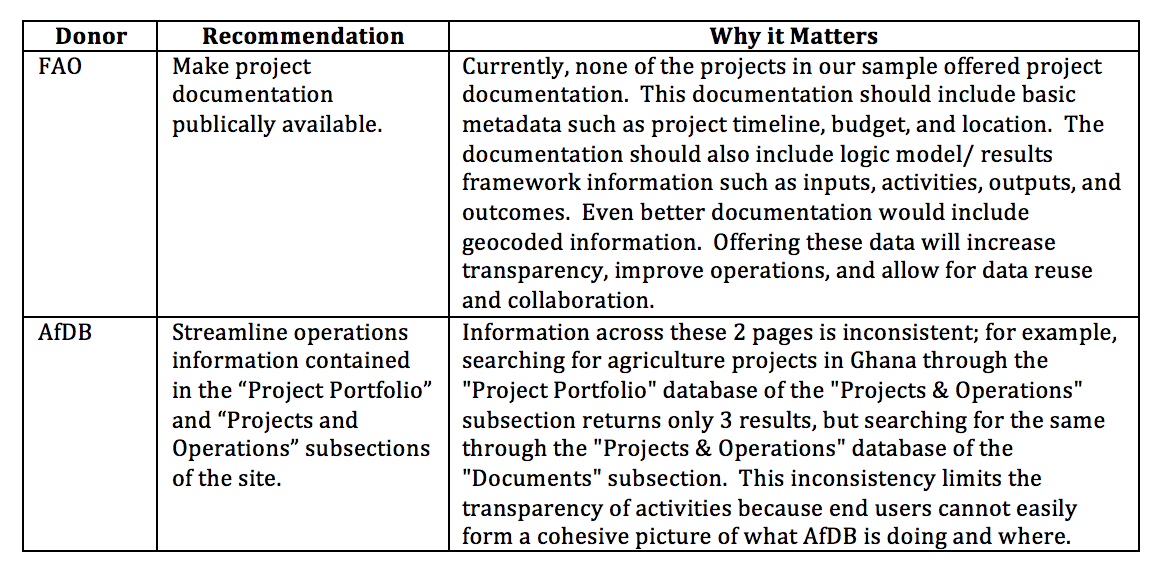The Results Data Scorecard: A glimpse at the importance and accessibility of results data
A key component of the Results Data Initiative (RDI) was the development of the Results Data Scorecard, a mechanism for assessing how development organizations gather and publish results information. Improving how DPs track and report results has the potential to reduce duplication of efforts and improve programming effectiveness – critical if we are to meet the SDGs.
So how accessible and useful are development partners’ results data? Not very: the most common source for results information is project documentation, oftentimes in PDF format. But based on our analysis, neither the PDF formats, nor differences across organizational templates, are major barriers to crosswalking results data. In fact, we were able to get the data through scraping and data algorithms. Rather, the key barrier to useful results data has to do with varying levels of data openness and completeness. By making improvements to existing internal reporting templates, development partners can make their information more accessible and comparable.
And that’s where the scorecard comes in. Our Scorecard – accessible at the bottom of the RDI data visualization page – assesses the quality of DP monitoring systems across five categories, and generates a composite score per organization.

Figure 1: World Bank’s Scorecard
The scores are based on a subset (not a complete sample) of results data sources from each DP. All sub-scores and the composite score are rated on a scale of 0-4, with 4 being the highest possible score; we’ll delve into the specifics of what each category means and the criteria (submetrics) that figure into the calculation in our next post. The goal of this Scorecard is not to name and shame DPs. Rather, we aim to illuminate ways in which existing M&E data, systems, and tools can be improved, to help DPs reach the goals they set for themselves.
To begin these conversations, we are using the results of our analysis to craft tailored recommendations on a DP-by-DP basis. Below is just a brief preview of a few recommendations we have included in our donor-specific Scorecard reports. We will present and discuss these in more depth in later posts.
Table 1: Sample Scorecard Recommendations

Table 1: Sample Scorecard Recommendations
While we continue our conversations with donors about our findings from the Scorecard exercise, readers can look forward to four upcoming posts that will provide deeper insight into our methodology, metrics, findings, and recommendations. We hope that series of posts will encourage development stakeholders to consider how revamping M&E and data systems can lead to cost savings, improved outcomes, and heightened accountability and transparency – stay tuned!
Share This Post
Related from our library

Building a Sustainable Cashew Sector in West Africa Through Data and Collaboration
Cashew-IN project came to an end in August 2024 after four years of working with government agencies, producers, traders, processors, and development partners in the five implementing countries to co-create an online tool aimed to inform, support, promote, and strengthen Africa’s cashew industry. This blog outlines some of the key project highlights, including some of the challenges we faced, lessons learned, success stories, and identified opportunities for a more competitive cashew sector in West Africa.

Digital Transformation for Public Value: Development Gateway’s Insights from Agriculture & Open Contracting
In today’s fast-evolving world, governments and public organizations are under more pressure than ever before to deliver efficient, transparent services that align with public expectations. In this blog, we delve into the key concepts behind digital transformation and how it can enhance public value by promoting transparency, informing policy, and supporting evidence-based decision-making.

From Data Gaps to Impact: Key Insights from the VIFAA Program
Over the last six years, DG, together with its partners AfricaFertilizer (AFO) and Wallace & Associates, collaborated to implement the Visualizing Insights on Fertilizer for African Agriculture (VIFAA) Program. In the program’s final year (2024), the team undertook a “program learning process” to reflect on outcomes, challenges, and successes through internal interviews. This blog captures five key learnings, which we hope will guide similar programs aiming to bridge data gaps in agricultural development.